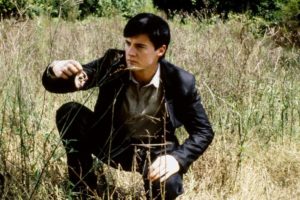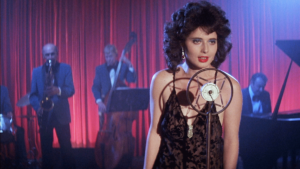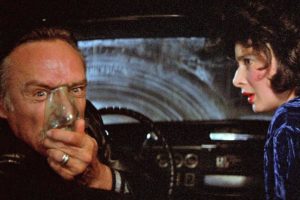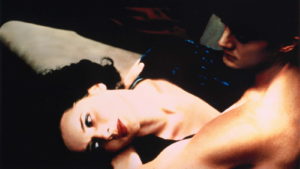Attend: Program Notes
Blue Velvet | David Lynch | United States | 1986 | 120 min.
Cinesthesia, Madison Public Library Central Branch, Thursday, October 4, 6:30 p.m.»
A mind-bending psychosexual odyssey and a visionary piece of popular transgressive cinema, David Lynch’s breakthrough film, Blue Velvet, looks at the underbelly of a picturesque, well-ordered American small town.
“Maybe I’m sick, but I want to see that again.” — Overheard after a showing of Blue Velvet
 A spellbinding, unprecedented mélange of classic film noir, pop surrealism, gothic horror, and avant-garde experimentation, Blue Velvet finds David Lynch at the peak of his career, while reinventing the art of cinema. In what remains his signature film, the visionary director boldly investigates the chaotic, nightmarish underworld lying just beneath the manicured surface of an idyllic, all-American small town.
A spellbinding, unprecedented mélange of classic film noir, pop surrealism, gothic horror, and avant-garde experimentation, Blue Velvet finds David Lynch at the peak of his career, while reinventing the art of cinema. In what remains his signature film, the visionary director boldly investigates the chaotic, nightmarish underworld lying just beneath the manicured surface of an idyllic, all-American small town.
Clean-cut college student Jeffrey Beaumont (Kyle MacLachlan) returns home to Lumberton, North Carolina after his father suffers a near-fatal stroke. When he discovers a human ear in an uncultivated field, his idle curiosity plunges him and a police detective’s wholesome, pure-hearted daughter (Laura Dern) into a bizarre erotic mystery involving a troubled nightclub singer (Isabella Rossellini) and an infantile, sadomasochistic thug who habitually takes amyl nitrite with an inhaler mask (Dennis Hopper).
In her review of Blue Velvet, Pauline Kael describes Lynch’s visual style as “hallucinatory clinical realism.” With one startling, painterly composition after another, the director juxtaposes the serene, immaculate façade of this artificial suburban paradise and its tainted, seamy underside. The iconic opening montage of the film presents a dreamlike series of archetypal American tableaux. Lynch’s low-positioned camera looks up at vibrant red roses bobbing against an impossibly clean white picket fence and clear blue skies. A shiny red old-fashioned fire truck coasts down a residential street in silent slow motion, while the cheerful fireman on the outside running board smiles and waves with a spotted Dalmation next to him.
Outside of the Beaumont house, a paunchy middle-aged man wearing sunglasses effortlessly waters his verdant lawn with a hose, while his wife sips coffee and watches a daytime television mystery inside. (Lynch’s Blue Velvet script includes a shot in which the man’s neighborhood and its dome of blue sky are reflected in a close-up of his dark glasses, but this image does not appear in the film.) All of a sudden, the hose gets caught on a bush, putting a disruptive kink in the water flow. Then, the man spasms, slaps his neck, and collapses as he is wracked by a massive seizure. He lies there writhing in agony, his hand rigidly gripping the hose as it aimlessly spurts water into the air and drenches his fallen body. The camera follows him to the ground and penetrates below the lush blades of vivid green grass to find a grotesque subterranean realm teeming with ravenous, glossy black beetles buzzing and hissing noisily.
 In his book David Lynch: Beautiful Dark, Greg Olson writes, “In a passage of bravura filmmaking, Lynch has taken us from the innocent red tulips of small-town serenity to the hungry, gaping mouth of hell.” Lynch proceeds to distort the binary relationship between light and darkness as Jeffrey embarks on a perilous descent into Lumberton’s netherworld and the deepest recesses of his own unconscious mind. The strange psychosexual adventures of this naïve, idealistic junior crimefighter will open his eyes to something that was always hidden both outside and within himself. In a 1995 interview, Lynch says, “If Jeffrey hadn’t found the ear, he would have walked on home, and that would’ve been the end of it. But the ear is like an opening, a little egress into another place, a ticket to another world that he finds.” He adds that, in Blue Velvet, the ear “draws Jeffrey into something he needs to discover and work though.”
In his book David Lynch: Beautiful Dark, Greg Olson writes, “In a passage of bravura filmmaking, Lynch has taken us from the innocent red tulips of small-town serenity to the hungry, gaping mouth of hell.” Lynch proceeds to distort the binary relationship between light and darkness as Jeffrey embarks on a perilous descent into Lumberton’s netherworld and the deepest recesses of his own unconscious mind. The strange psychosexual adventures of this naïve, idealistic junior crimefighter will open his eyes to something that was always hidden both outside and within himself. In a 1995 interview, Lynch says, “If Jeffrey hadn’t found the ear, he would have walked on home, and that would’ve been the end of it. But the ear is like an opening, a little egress into another place, a ticket to another world that he finds.” He adds that, in Blue Velvet, the ear “draws Jeffrey into something he needs to discover and work though.”
Lynch has also said that Blue Velvet is “a trip into darkness, as close as you can get, and then a trip out. There’s an innermost point, and from then on it pulls back.” Jeffrey’s wayward journey comes to a head when he steps across the threshold of Dorothy’s apartment into the hallway and encounters Frank with three of his depraved cohorts. Frank takes the trembling youth for a ride, first to the hangout of one of his business associates and then to a deserted spot, where he repeatedly strikes Jeffrey, while a large-headed prostitute in a short, pink skirt impassively dances on the roof of the car to Roy Orbison’s “In Dreams.” (In Lynch’s script, Jeffrey was to wake up lying on the ground after being beaten unconscious by Frank. His pants were to be pulled down and the words “FUCK YOU” scrawled on his leg with lipstick in the aftermath of a homosexual rape. However, Kyle MacLachlan pleaded with Lynch to remove the sexual violation details, and after giving the matter some thought, the director acquiesced to his wish.)
Discussing the genesis of his film in 1987, Lynch told Cineaste that “the first idea was only a feeling and the title Blue Velvet. The second idea was an image of a severed ear lying in a field. I don’t know why it had to be an ear, except it needed to be an opening of a part of the body, a hole into something else. The ear sits on the head and goes right into the mind, so it felt perfect. The third idea was Bobby Vinton’s song ‘Blue Velvet.’” He didn’t like the song when it came out, though. In his recent book Room to Dream, a hybrid of biography and memoir co-written by journalist Kristine McKenna, Lynch reflects,
“Blue Velvet” was schmaltzy and didn’t do a thing for me. Then I heard it one night and it married with green lawns at night and a woman’s red lips seen through a car window—there was some kind of bright light hitting this white face and these red lips. Those two things, and also the words “and I still can see blue velvet through my tears.” These things got me going and it all married together.
Lynch wrote the Blue Velvet script while listening to Dmitri Shostakovich’s Symphony No. 15 in A Major. An important piece of the puzzle that had eluded him was the climactic finale to the story, but then the solution purportedly came to him in a dream. Lynch’s dream was set in the living room of the apartment of Dorothy Vallens and involved a pistol and a police radio. With those simple elements the director was able to bring the narrative to a conclusion, and he completed a final shooting script dated July 24, 1985.
While determining the final form of his story and its setting, Lynch began casting the principal roles. He chose Kyle MacLachlan to play Jeffrey “because Kyle is an innocent, and he’s kind of all-American in a way that makes you think about the Hardy Boys.” Oliver Stone had offered MacLachlan a leading role in the highly anticipated production of Platoon, but the actor felt that the part of Jeffrey made a far more fascinating journey than the comparatively undeveloped lead character of Platoon. Lynch had talked to just about every young actress in Hollywood before he found Laura Dern. She was only seventeen years old and had starred in two films—Mask and Smooth Talk—when she first met him to discuss Blue Velvet.
In a serendipitous way, Italian film producer Dino De Laurentiis would provide the actress to portray Dorothy. One night in New York, Lynch and a male friend were having dinner in Dino’s restaurant when he said to an uncommonly beautiful woman sitting across the room, “You could be Ingrid Bergman’s daughter.” Somebody said, “Stupid! She is Ingrid Bergman’s daughter!” Thirty-three-year-old Isabella Rossellini was indeed the daughter of actress Ingrid Bergman and Italian film director Roberto Rossellini. Even before meeting Lynch, she had been swept away by his Blue Velvet screenplay. In her 1997 book Some of Me, Rossellini recalls that the script opened up “a world of deeper truths,” while bravely depicting “the reality of abused women, the many layers, the horrible twists, the unclear emotions.”
 As for the character of Frank Booth, it took Lynch a while to wend his way to Dennis Hopper. Willem Dafoe came in to discuss the role, and Lynch offered it to Harry Dean Stanton, who said, “I didn’t want to go on that violent trip,” and turned it down. By the mid-1980s, Hopper had developed a wild reputation that overshadowed his gifts as an actor, painter, photographer, and director (Easy Rider, 1969). He maintained a militantly anti-establishment stance throughout his career, while his professional and personal life spiraled down into drug addiction, explosive rage and psychotic behavior. Lynch had put Hopper on his first list of possible actors to play Frank, but he was told not to hire him. However, since Hopper was absolutely out of control, his friends had intervened and got him into a detoxification program. His agent called Lynch and said he was clean and sober. Then one day, the director’s phone rang, and Hopper declared, “I have to play Frank Booth because I am Frank Booth.”
As for the character of Frank Booth, it took Lynch a while to wend his way to Dennis Hopper. Willem Dafoe came in to discuss the role, and Lynch offered it to Harry Dean Stanton, who said, “I didn’t want to go on that violent trip,” and turned it down. By the mid-1980s, Hopper had developed a wild reputation that overshadowed his gifts as an actor, painter, photographer, and director (Easy Rider, 1969). He maintained a militantly anti-establishment stance throughout his career, while his professional and personal life spiraled down into drug addiction, explosive rage and psychotic behavior. Lynch had put Hopper on his first list of possible actors to play Frank, but he was told not to hire him. However, since Hopper was absolutely out of control, his friends had intervened and got him into a detoxification program. His agent called Lynch and said he was clean and sober. Then one day, the director’s phone rang, and Hopper declared, “I have to play Frank Booth because I am Frank Booth.”
Although Blue Velvet was born from the mind of Lynch, the four main players bring his script to vivid life. The role of Jeffrey seems tailormade for MacLachlan’s engagingly youthful zeal and idiosyncratic playfulness. As Jeffrey’s angelic teenage sweetheart Sandy, Dern positively radiates with virtue, love and innocence. The two performers work together like magic and, in reality, they began a romantic affair. Rossellini holds back nothing and delivers a fearless, convincing performance as the film’s tragic femme fatale. And Hopper embodies the deranged, uncontrollable Frank with fierce, commanding authenticity.
The unique look of Blue Velvet anticipates the fluid relationship with time that would shape Lynch’s subsequent work. At the Slow Club, where Dorothy performs, she sings into a vintage microphone from the 1920s, her apartment calls to mind a 1930s art deco movie set, and she has a television with a 1950s rabbit-ears antenna. Arlene’s, the local diner where Jeffrey and Sandy conspire, also suggests the 1950s, but Jeffrey’s tiny gold earring and Sandy’s clothing are distinctly 1980s. Sandy has a poster of Montgomery Clift on her bedroom wall, while classic American cars roam the streets of Lumberton. Greg Olson comments, “In Blue Velvet, Lynch is pioneering a subtly stylistic motif that other filmmakers will try to copy; he’s giving us an evocative dream time, an ambiguous mix of various decade signifiers in which we float around, subtly disconnected from the waking realities of our own time-bound lives.”
Working with his longtime associate, the cinematographer Frederick Elmes, Lynch essentially paints with light to heighten the film’s atmosphere and achieve the rich texture of Blue Velvet. “Half of the shooting schedule was at night, and the lighting in those scenes was complicated,” Elmes remembers. They shot on a street without streetlights, so the power company put in poles and they wired them up with lights.
Lynch collaborated with sound designer Alan Splet to create an innovative soundscape for Blue Velvet. The film interweaves natural sounds and music with mechanical-industrial noises that give Lynch’s images an eerie undercurrent. When Jeffrey ascends the seven flights of stairs to Dorothy’s apartment, the building has a pumping, groaning sound; a metallic screech accompanies Frank’s eruption of rage; the camera moves into the dark canal of a decaying human ear and we hear the roar of a sinister wind.
Lynch’s intuitive grasp of how to combine images and sound truly distinguishes his cinematic poetry, and beginning with Blue Velvet, music became central to the director’s artistic expression. In the words of Pauline Kael, “Blue Velvet suggests a musical on themes of our pop unconscious.” The cleverly offbeat use of innocuous, sentimental popular songs layered in and out of Angelo Bandalamenti’s orchestral score enhances the pervasive feeling of being outside of linear time, while also advancing the narrative.
The story behind the unusual robin that appears in the final scene of Blue Velvet exemplifies Lynch’s resourcefulness in solving the various creative problems that inevitably arise during the making of a film. Robins and their nests are protected under the Migratory Bird Treaty Act, so it is not easy to obtain one. However, Lynch needed a robin. Producer Fred Caruso found a trainer who said he had a trained robin, but they brought it to the set and it was inadequate. Elmes recalls, “It was a molting robin in a cage that looked so sad; plus, there’s no such thing as a trained robin!” As the end of the shoot approached, they got nervous about this. Then, by chance, a robin flew into the side of a school bus and fell down dead.
Some kids saw the dead robin and decided the biology department at school could use a robin, so they had it stuffed, and on the way back from the taxidermist it took a detour past our set. David mounted the robin on a windowsill and put a live bug in its mouth, and now we had a stuffed robin that didn’t move. So David took monofilament threads, tied them to the robin’s head so it would move, then got down in the bushes below the window and manipulated the threads. He’s down there asking, “Is he looking the right way?” I said, “I think you got the puppetry down as good as it can get, but it still looks kind of mechanical.” He said, “Yeah, yeah, that’s it!” The robin had this unearthly quality, and I think he loved the artificiality of it.
Blue Velvet was screened for the first time at De Laurentiis’s headquarters on Canon Drive in Beverly Hills. A handful of people were there, and when the movie finished and the lights came on, everyone looked at each other in silence. Finally, De Laurentiis said that no one would want to distribute the picture, so he formed his own distribution company and paid for distribution, prints and advertisements.
 The film officially premiered in competition at the Montreal World Film Festival in August of 1986, and it opened commercially in the United States on September 19, 1986. While the film initially polarized critics and some audiences were not ready for it, Blue Velvet earned Lynch an Academy Award nomination for Best Director. No prior or subsequent film has generated as much popular and scholarly interest or as much criticism (among feminists for the violence toward women, among conservatives for the perverse image of small-town America, and among Marxists for the seeming nostalgia for the 1950s). Blue Velvet ultimately resurrected Hopper’s career, went on to become a staple of film school curricula around the world, and is generally considered one of the greatest American films ever made.
The film officially premiered in competition at the Montreal World Film Festival in August of 1986, and it opened commercially in the United States on September 19, 1986. While the film initially polarized critics and some audiences were not ready for it, Blue Velvet earned Lynch an Academy Award nomination for Best Director. No prior or subsequent film has generated as much popular and scholarly interest or as much criticism (among feminists for the violence toward women, among conservatives for the perverse image of small-town America, and among Marxists for the seeming nostalgia for the 1950s). Blue Velvet ultimately resurrected Hopper’s career, went on to become a staple of film school curricula around the world, and is generally considered one of the greatest American films ever made.
The elements of Blue Velvet are too complex and multi-layered for any kind of definitive explanation. Yet Lynch’s deeply personal film overflows with intention and meaning, in that the director meticulously attended to every possible detail of its creation. Although many have attempted to interpret Blue Velvet as an accumulation of Freudian symbols, Lynch’s film defies the logical reductionism of language. Rather than something to be understood intellectually, Blue Velvet reaches the receptive spectator at an inner level of consciousness, just as music does, while yielding fresh discoveries upon each successive viewing.
At once a warped coming-of-age story, a provocative look at the dualities of American fantasy life, an inspired, singular work of art, and a powerful, transcendent cinematic experience, Blue Velvet continues to influence our collective imaginations. Lynch’s lurid masterpiece has withstood the passage of time better than most movies precisely because of the purity of his artistic vision and his faithfulness to ideas. While the film’s disturbing sexual content and extravagant flourishes of violence may not appeal to all tastes, none of the scenes in Blue Velvet feel arbitrary or gratuitous. Viewers who completely surrender to its magnetic flow of audiovisual stimuli will notice that the film can in fact induce a trancelike state. Pauline Kael observes that “Lynch’s use of irrational material works the way it’s supposed to: at some not fully conscious level we read his images.” Through the director’s uninhibited expression of his ideas, his ever shifting, elusive tones, his dark, absurdist sense of humor, and his sensuous, assured editing rhythms, Blue Velvet realizes the potential of cinema to transport us to worlds we never knew existed.